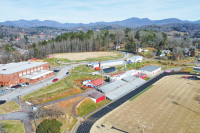Dam escaped state permit threshold: Cause of failure stemmed from construction techniques
Balsam Mountain Preserve is off the hook on one front: it didn’t need a permit from the state dam safety office before constructing a dam at its golf course.
The earth dam, which held back an irrigation pond, collapsed in early June. Immediately following the dam break, it was unclear whether Balsam Mountain Preserve should have gotten a permit for the dam’s construction.
A permit is required if the dam meets one of two litmus tests. The first is if it is taller than 15 feet and holds back 10 acre feet of water — defined as a 10-acre pond one-foot deep, or one-acre pond 10-feet deep, or any variation there of. A dam also needs a permit if its failure poses a potential hazard downstream.
Based on the report of an engineer hired by Balsam Mountain Preserve, the state has ruled that a permit was not needed.
“We felt comfortable that it did not require a permit we are happy they agreed with that assessment,” said Chris Crouch, golf course manager who is now overseeing the cleanup.
Balsam Mountain Preserve’s dam did not qualify as a high-hazard dam, said Max Fowler, state dam safety officer in Raleigh. That is evident by the fact that it failed but caused no loss of life or injury. Property damage downstream is limited to environmental devastation, altered stream channels and washed out yards, but no structural damage.
The other litmus test that would trigger a permit — the height of the dam and volume of water it held — was more iffy. At 36 feet, the dam certainly exceeded the height requirement. But did it hold 10 acre feet of water? The state required Balsam Mountain Preserve to hire an engineer to determine the pond’s volume prior to the dam break.
According to that engineer, the dam only held 7.5 acre feet of water — the surface of the pond was 0.76 acres and the pond was 14-feet deep — coming in below the threshold.
“According to the engineer’s report, the dam did not hold 10 acre feet or more of water,” Fowler said.
The state did not send its own engineer to check the figures provided by Balsam Mountain Preserve’s engineer, but said it has no reason not to trust the report.
“The engineer and surveyor hired by the dam owner are licensed by the State of North Carolina. The licensing rules place the welfare of the public safety above the service to the client. These professionals risk losing their livelihood should they present inaccurate or false data,” said Jim Simons, the director of the state Division of Land Resources, which is over the dam safety unit.
While the state hasn’t done official calculations of its own, it did review the numbers, Simons said.
“Our dam safety engineers have seen the lake, reviewed the surveyor’s information and determined that the surveyor’s calculations appear reasonable,” Simons said.
Tough enough?
Given the ecological devastation caused by the dam failure, it begs the question whether the threshold that triggers a permit should be tougher. However, Simons said the “current threshold for dam safety jurisdiction generally appears to be working.”
That said, dams that don’t go through the permit process have a higher failure rate than dams that are subject to oversight, Simons said.
“Certainly, the dam safety permitting process provides an assurance that the dam meets a certain standard that may or may not be present if the dam is not permitted,” Simons said.
In an interview the week after the dam break, Fowler guessed the failure was caused by poor design of the dam’s outflow pipe — a pipe buried at the base of the earth dam that lets water pass through from the pond on the other side into the creek below. Had Balsam Mountain Preserve applied for a permit, Fowler said at the time he would have taken issue with the design of the outflow pipe. It turned out Fowler was right.
Balsam Mountain Preserve was required to hire yet another engineer to examine the cause of the dam failure. The engineer concluded that soil around the outflow pipe had slowly eroded, creating a weak spot in the dam’s wall.
The soil packed around the metal pipe was a bad consistency in the first place and wasn’t compacted properly, according to the engineer’s report. Plus, the outflow pipe wasn’t fitted with the proper seep collar system. All that led to a slow erosion of the earth dam around the pipe.
“The breach resulted from unsuitable soils and inadequate compaction around the outflow pipe and seepage collar,” according to the engineer’s report filed with the state. “No provision for seepage control was provided in the downstream portion of the dam foundation. No compaction testing was performed during fill placement.”





